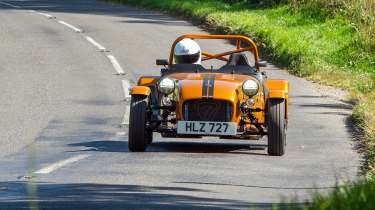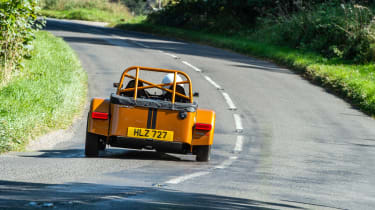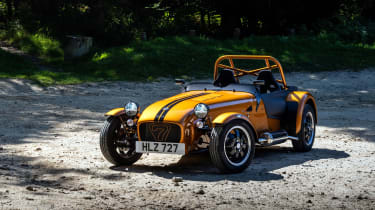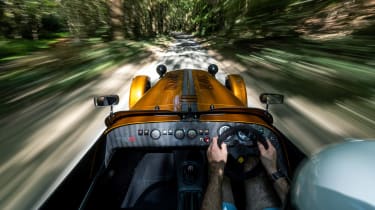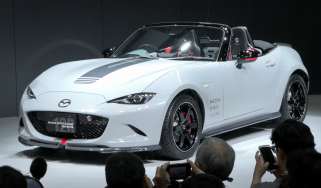Caterham Seven 170R 2021 review
The Seven 170 is one of Caterham’s purest models to date, and we’ve put the R variant through its paces
The new Caterham 170 model, available in both road-biased ‘S’ and more track-focused ‘R’ varieties - is the first ‘new’ Seven to arrive following the firm’s sale to Japanese owners, and also just happens to be the lightest Seven that Caterham has ever made at 440kg.
Think of it as a replacement for the now departed 160 model, which captured the headlines with its keen price and back-to-basics approach. That original 160 had 80bhp and 79lb ft of torque from its 660cc Suzuki turbocharged three cylinder engine to push along 490kg, whereas this one has 84bhp and 86lb ft to get just 440kg moving (if specified in R form and with no windscreen; note, R-spec wasn’t an option before).
The screen-less, carbonfibre rich 170R looks every inch the hardcore Seven, until that is you spot the very narrow track and a set of Avon ZT7 tyres (155/65/R14s all-round) that look more like something suitable for a trad 1960s British sports car.
> Caterham 620R v Ariel Atom 3.5 v Elemental Rp1
However, one of the great things about low mass vehicles is that it doesn’t take much to effect a big change. It may only have 4 additional horses to call on, but given it’s so light you feel as though you could just pick it up by the roll bar and walk off with it, that extra shove from the tiny Suzuki triple should make a very tangible difference. As it’s an R, this one also has a limited slip differential, sports suspension, carbon seats and very little in the way of weather protection. There are also a few new developments on show here, such as LED rear lights.
Having wriggled into the uncompromising embrace of the bucket seat, the triple fires with a fairly restrained, thrummy idle, its presence felt through its own vibratory signature. The five speed box now has a very short, deliciously mechanical throw, and predictably, the 170 seems to just skip off the line with the zest of an agitated fly. I must confess I liked the idea of the old 160 more than the actual reality: I just wanted more performance, more edge to it. It was fun for a while but rather than work around its limitations I soon grew frustrated and distracted by the thought of a second hand ‘proper’ Caterham. This feels like it might be different.
More reviews
It doesn’t take very long to get a feel for what the engine can offer. It’s a bit sleepy below 2500rpm, but from 3000-5000 there’s a solid and energetic shove, which then builds over the subsequent 2000rpm to if not quite a frenzy, then with at least decent enthusiasm. I had expected it to feel a bit breathless up high, but not a bit of it, and neither do I remember the old 160 Suzuki engine gasping and sneezing like an old Group A rally car every time I lift the throttle.
In isolation this is excellent, but a bit of context is a wonderful thing. At one point, on a slight incline leaving a roundabout, the 170R just about manages to outdrag a Renault Traffic van. Essentially, the 170R can reach 60mph from rest in just under seven seconds, and burst triumphantly through the 100mph barrier. It’s like 1990s hot hatch performance coupled with the aerodynamics of a brick outbuilding.
The question I keep asking myself is ‘does this really matter’? And the more I think about it, the more I realise that what frustration there is stems not from the overall lack of pace, but has much more to do with the lack of graduation to the 170’s delivery. Yes, you can roll along with a light throttle, but for anything approaching energetic driving it’s simply 100% throttle all the way, and I find myself missing the necessity to think more carefully about how much throttle to use, and where. Even when pulling out of a T junction and giving it the full 84bhp, the 170 won’t spin up and kick its tail out, and that’s with a slippy diff, remember.
Nevertheless, the differential is a very welcome addition, because there’s none of that impotent, inner wheel spin that even the 160 could display if you really provoked it. Instead, the 170’s dynamic repertoire feels more grown up. Sevens always feel hyper agile, but this one takes it to the extreme: my eyes flit to the right and the 170 seems to head in that direction without the slightest delay, and then if the road switches back to the left the car leaps the opposite way with no inertia whatsoever. To be honest, it takes time to recalibrate the brain to this sort of behaviour, and while that’s taking place confidence is the main issue. While that might sound ridiculous in a car with a mere 84bhp, there’s the sensation of it floating along, almost above the road’s surface, a nagging constant doubt about whether those hopelessly primitive tyres will actually key into the road and provide control.
In fact, outright grip isn’t a concern. The cornering force the 170R manages to concoct from a 155-section tyre is outstanding, and you soon learn to trust it, aware, perhaps more than anything, that every single input - no matter how small - or every influence on the tyres’ behaviour will have a cause and effect relationship to the car. Make a mess of a heel and toe downshift and there’s a mild locking of the wheels; be overly aggressive on turn-in and the four contact patches get excited. Use that to your advantage and at that point you’re really driving the 170R, dancing along.
The unexpected double-edged sword of the 170 is that while its very nature makes it so very applicable to our everyday roads, so also to actually enjoy it do you need commitment: you can’t jump on the throttle mid corner and get your kicks that way, you’ve got to be fast in, up on the tip-toes, working the front and rear simultaneously - and that takes a bit of space and confidence of a clear road ahead.
There’s also the issue that with its live rear axle, the 170R gets quite excited if the road turns bumpy, or poorly surfaced; a 170R driver learns to read the road’s surface like someone on two wheels might.
Prices and rivals
The 170 significantly undercuts the next rung on the Caterham ladder - the near-30 grand 270 - by starting at £22,990 as a kit in S form, with the R coming in at £23,990. That’s a lot more than the old 160 was listed from, but then that was an artificially low price in many ways as it didn’t include some essentials - the base 170 is at least driveable on the road. Nevertheless, it’s worth bearing in mind though that this particular car equates to about £31,605, so as ever, it’s possible to let the cash run away as you tick options.
Rivals are very thin on the ground unless you investigate the kit car market. You could of course buy a new Hyundai i20N for £25,000 - a more different if still equally entry-level performance car it’s hard to imagine.

